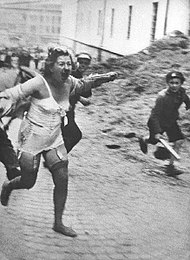Petljura-dagarna

Petljura-dagarna avser det de ukrainska nationalisterna kallar pogromerna mot judar i Lvov den 25–27 juli 1941, efter att staden hade intagits av tyskarna under Operation Barbarossa. Flera tusen judar dödades i denna pogrom. Namnet kommer av den år 1926 mördade nationalistledaren Symon Petljura som lett pogromer under självständighetskampen 1919.[1]
Filip Friedman och Jakob Weiss, som överlevde Lvovpogromerna 1941, publicerade år 2010 boken The Lemberg Mosaic: Memoirs of Two who Survived the Destruction of Jewish Galicia. I boken framhåller författarna den Ukrainska upprorsarméns, polisens och allmänhetens aktiva roll i mördandet och förnedrandet av judarna i Lvov.
Referenser
- ^ Lvov Holocaust Encyclopedia, United States Holocaust Memorial Museum. Läst 4 november 2016
Media som används på denna webbplats
Photograph of the Lviv pogrom on or around 1 July 1941 in Lviv, German-occupied Poland (now Ukraine). The Germans encouraged attacks on the Jewish community in two pogroms, 30 June – 2 July 1941 and 25 – 29 July 1941, during which around 6,000 Polish Jews were killed by Ukrainian nationalists and local people. John-Paul Himka (2011). "The Lviv Pogrom of 1941: The Germans, Ukrainian Nationalists, and the Carnival Crowd". Canadian Slavonic Papers 53 (2–4): 209–243.: "A woman stripped to her underwear is being chased by a uniformed boy with a stick as well as by an adolescent. The action is taking place near Zamarstyniv street prison [Lviv], on a street then called Pompierska. Now that street is called Vesela, that is, HappyStreet. (Courtesy of Wiener Library)" (p. 233). "One of the characteristic features of the pogrom was the maltreatment and humiliation of Jewish women. The scenes at Zamarstyniv street were photographed by a German camera crew; there is also a film of the abuse" (p. 213). Of this image, figure 4: "In the women's action of 1 July, memoirs and photographs show the perpetrators as mainly grown men, but also teenagers and even children (Figure 4)" (p. 233). Himka writes of the photographs: "The major collection of photographs is in the Wiener Library, photos 1615, 1618, 1635, 1650, 1676, 1677 (photo 1647 actually shows a naked and bloodied man). These photos are frequently reproduced. ... Another photo from this same incident is in USHMM, Photo Archives, 86319" (p. 213, note 13). There is also a film of the pogrom: "USHMM Film Archive, tape 402, story RG-60.0441. This film is in very damaged condition. But many stills made from a less deteriorated copy are available in USHMM, Photo Archives, 73666" (Himka, p. 213, note 14). For more on the film, see below.
